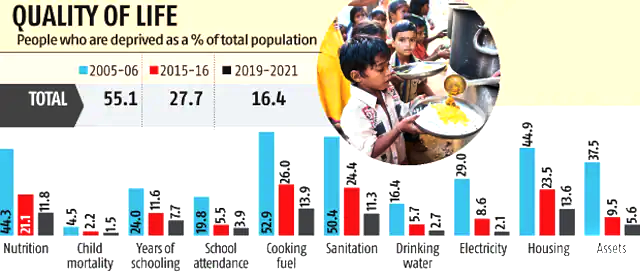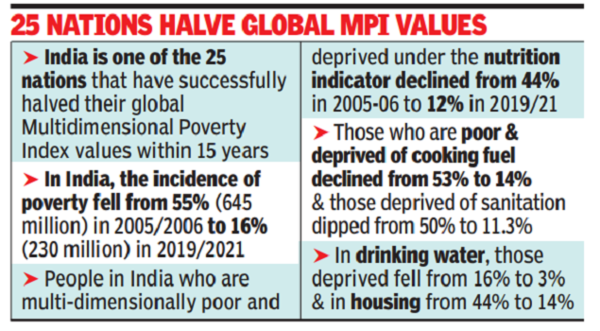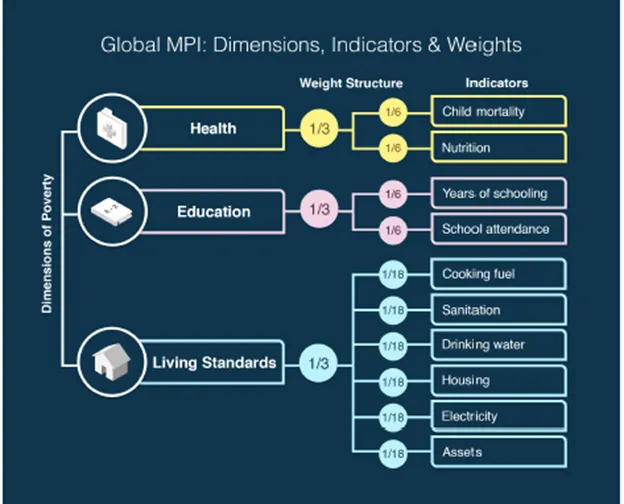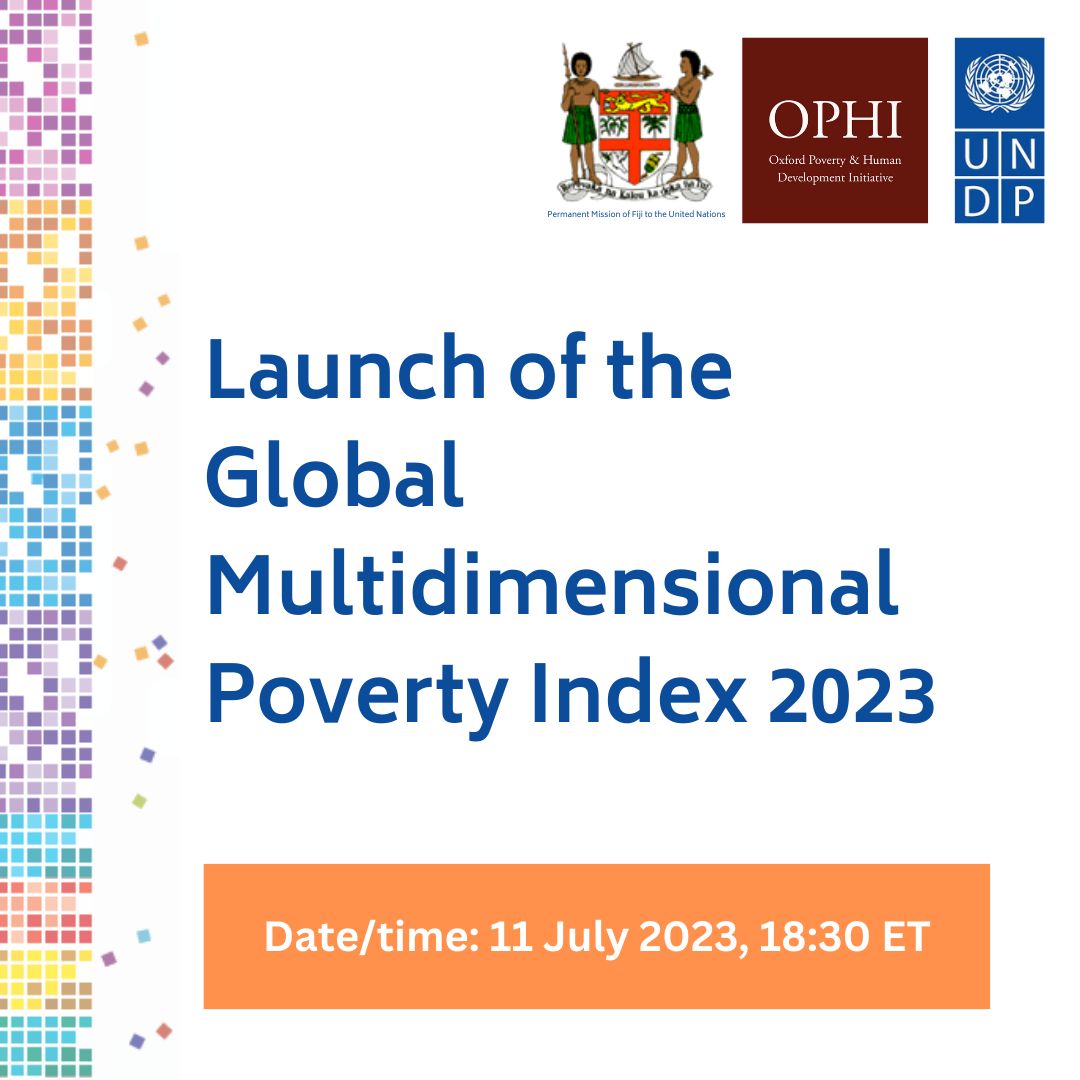The latest update of the global Multidimensional Poverty Index (MPI) highlights India’s extraordinary achievement in poverty reduction. The country has lifted a staggering 415 million people out of poverty within a span of 15 years, demonstrating significant progress in improving living conditions. This article examines key highlights from the MPI report released by the United Nations Development Programme (UNDP) and the Oxford Poverty and Human Development Initiative (OPHI).
India’s Journey: From High Poverty Incidence to Impressive Decline:

- In 2005/2006, India had a poverty incidence of 55.1%, with approximately 645 million people living in poverty.
- Through concerted efforts and effective policies, poverty rates have dropped to 16.4% in 2019/2021, showcasing substantial improvement in living conditions.
- The decline in poverty has been equal across regions and socio-economic groups, with the poorest states and groups experiencing the fastest progress.
Poverty Reduction Trends in Selected Countries (2000-2022)
| Country | Period | Poverty Incidence (2000/2005) | Poverty Incidence (2019/2021) | Number of People Lifted out of Poverty |
|---|---|---|---|---|
| India | 2005/6-2019/21 | 55.1% | 16.4% | 415 million |
| China | 2010-2014 | N/A | N/A | 69 million |
| Cambodia | 2014-2021/22 | N/A | 16.6% | 2.8 million |
| Indonesia | 2012-2017 | N/A | N/A | 8 million |
Children and Rural Areas: Key Factors in Poverty Reduction:
- Children under 18 years old account for half of MPI-poor people, emphasizing the importance of addressing child poverty through comprehensive programs for their well-being, education, and access to essential services.
- Poverty predominantly affects rural areas, with 84% of the country’s poor residing in these regions. This underscores the need for targeted measures to uplift rural communities and bridge the urban-rural divide.
Global Outlook
Poverty Incidence in Selected Countries and Regions
| Country | Region | Poverty Incidence (%) |
|---|---|---|
| Burundi | Sub-Saharan Africa | 75.1 |
| Central African Republic | Sub-Saharan Africa | 80.4 |
| Chad | Sub-Saharan Africa | 84.2 |
| Niger | Sub-Saharan Africa | 91 |
| Afghanistan | South Asia | 55.9 |
| Haiti | Latin America | 41.3 |
| Papua New Guinea | East Asia | 56.6 |
| Sudan | North Africa | 52.3 |
| Tajikistan | Central Asia | 7.4 |
- Globally, 1.1 billion people (18% of the total population) across 110 countries live in acute multidimensional poverty.
- Sub-Saharan Africa has 534 million poor, while South Asia has 389 million, making these regions home to approximately five out of every six poor people.
- Children under 18 years old account for 566 million MPI-poor people globally, with a poverty rate of 27.7%, compared to 13.4% among adults.
Outlook for India:
- Despite significant progress, India still has more than 230 million people living in poverty.
- The UNDP highlights the vulnerability of the population, with approximately 18.7% falling under the category of people who are not poor but have deprivations in 20-33.3% of all weighted indicators.
Improvement in Deprivation Indicators:

- India has shown significant progress in all three deprivation indicators: health, education, and standard of living.
- The percentage of people deprived of nutrition decreased from 44.3% in 2005/2006 to 11.8% in 2019/2021, and child mortality fell from 4.5% to 1.5%.
Recommendations:
- There is a need for context-specific multidimensional poverty indices that reflect national definitions of poverty.
- While the global MPI provides a standardized methodology, national definitions offer a comprehensive understanding of poverty specific to each country.
- It is crucial to consider these context-specific indices to evaluate and address poverty effectively.
About Global Multidimensional Poverty Index (MPI):
The Global Multidimensional Poverty Index (MPI) is a vital international resource designed to measure acute multidimensional poverty in over 100 developing countries. Launched in 2010 by the Oxford Poverty and Human Development Initiative (OPHI) and the Human Development Report Office of the United Nations Development Programme (UNDP), the MPI provides a comprehensive assessment of poverty beyond monetary measures.

-
Purpose and Scope: The MPI serves as a crucial tool to gauge the extent and nature of multidimensional poverty worldwide. It focuses on capturing various dimensions of poverty, including health, education, and standard of living, to provide a holistic understanding of people’s well-being. It is applied across a broad range of developing countries, offering insights into the multifaceted challenges faced by different societies.
-
Monitoring Deprivations: The MPI monitors deprivations in 10 key indicators that span the domains of health, education, and standard of living. These indicators are carefully selected to reflect the essential aspects of individuals’ lives and well-being. By analyzing these indicators, the MPI provides a nuanced picture of poverty and identifies the specific areas where people face significant deprivations.
-
Incidence and Intensity of Poverty: The MPI considers both the incidence and intensity of poverty. A person is classified as multidimensionally poor if they are deprived in one-third or more (33% or more) of the weighted indicators out of the ten indicators. Those who face deprivations in half or more of the weighted indicators are considered to be living in extreme multidimensional poverty. This dual perspective helps to capture the severity and depth of poverty experienced by individuals and communities.
MPI Indicators and Dimensions: The MPI incorporates a diverse range of indicators and dimensions to comprehensively assess poverty. While the specific indicators may vary across countries, the following are commonly included:
- Health Indicators:
- Nutrition and food security
- Child mortality
- Access to healthcare
- Education Indicators:
- School attendance
- Years of schooling completed
- Standard of Living Indicators:
- Access to clean water and sanitation
- Electricity and cooking fuel availability
- Housing quality
- Assets ownership




 Which is the Highest Desert in the World...
Which is the Highest Desert in the World...
 U-19 Asia Cup Schedule 2025: Full List o...
U-19 Asia Cup Schedule 2025: Full List o...
 U-19 Asia Cup 2025, Vaibhav Suryavanshi ...
U-19 Asia Cup 2025, Vaibhav Suryavanshi ...







